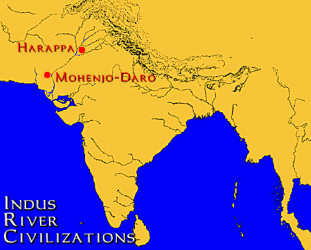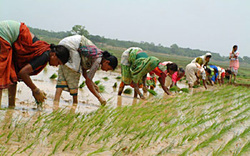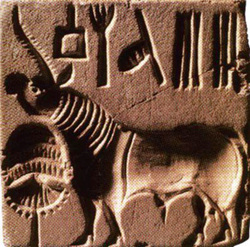प्राचीन भारत Ancient India
The Harappan Civilization
Harappan Society
About 6000 years ago in the lower Indus Valley, small villages consisting of huts made of mud,were located in modern day Pakistan; eventually they rose to communities that made up the Harappan civilization. Back in the 3rd and 4th millenniums B.C.E., the Indus Valley received a lot of rainfall; and since the Indus River was close to the inhabitants of the valley, much of the river's tributaries were able to provide the people with a stable resource for food and shelter. Many scholars, today, argue that the Harappan civilization is not a lost civilization; they claim that the Dravidian peoples who were present on the Deccan plateau had a similar language and culture to that of the Harappan civilization.
Devolopements

The Harappans developed out of an agrarian state. There were several tiny villages that could sustain a wealthy ruler; the villages grew into prominent, walled cities. The most powerful cities of the Harappan civilization were Harappa and Mohenjo-Daro.
Harappa

The city of Harappa and Mohenjo-Daro were actually very much alike, but the city of Harappa is probably the most remembered out of the two. Harappa was surrounded by a 40 goot thick, 3.5 mile circumference long wall.
Both cities' neighborhoods had walls surrounding the houses, and the roads for the city were as long as 30 feet wide. The houses ranged from 1 to 3 stories with a courtyard outside the house that was surrounded by the rooms. The Harappan's also had one of the most developed drainage systems. The dirty water would be carried through a system of sewage to be brought outside of the city walls. A separate area for the poor was made near the furnaces and grain fields.
Both cities' neighborhoods had walls surrounding the houses, and the roads for the city were as long as 30 feet wide. The houses ranged from 1 to 3 stories with a courtyard outside the house that was surrounded by the rooms. The Harappan's also had one of the most developed drainage systems. The dirty water would be carried through a system of sewage to be brought outside of the city walls. A separate area for the poor was made near the furnaces and grain fields.

The Harappan political organization was not based upon a monarchy; it was composed of scattered towns and cities that were ruled by alliances of merchants and landlords. The only connection between the cities was the trade that took place among them. Archaeologists have not been able to find any existing monuments present during the time.

Workers in a paddy field
The Harappans, as mentioned before, were known for agriculture. They produced crops such as wheat, barley, rice, and peas. The Harappans are also known as the first users and cultivators of rice and cotton. An extensive trading network also developed in Harappa, in which metal, copper, lumber, precious stones, and cloth would be traded via land or by the Arabian Sea.

The Arabian Sea....today

The sophisticated culture of the Harappans shines in their architecture that is made for functionality, paintings of lively animals and sculptures of elephants, tigers, rhinos, and antelopes reflected the Harappans' love of nature , vivid color, and religious beliefs. The only writing found of the Harappans was in pictographic symbols on clay. They have yet to be deciphered.
Mohenjo Daro

The people of Mohenjo Daro, the most populous city in Ancient India, at the time Harappa was still there, can best be described as sailors and traders. Since the Indus River provided a source of food and wealth for both cities, the people of Mohenjo Daro used the river, now located in Pakistan, to its extents. The city of Mohenjo Daro took up 250 acres in today's measurements, and it rested on several dirt mounds.

The Great Bath
The political structure was uniform; each mound was ruled by an elite or wealthy person. The greatest artifact that has been left behind in Mohenjo Daro, was the "Great Bath." This bath was a type of common bathing place for the citizens of the city. The bath is made of baked brick and replaces the temple place for the citizens; at least, that is what researchers claim. To summarize, the two cities of Harappa and Mohenjo Daro are, in truth, two large mysteries to archaelogists and historians. They just do not know how the civilizations came to an end. Researchers have only come up with one conclusion: since the Indus River has changed dramatically in relation to its pathway, the economy and trade of the cities might have been affected and caused a decline of wealth that led to their ruin.
Lost Civilization?

There have been several theories floating around for decades on how the Mohenjo Daro and Harappan civilizations came to an end. Researchers at the two sites have found that there was a slow decline at first but it sped up suddenly during 1500 B.C.E.

One theory suggests that the two cvilizations declined when it was atttacked by the Arayans in 2000 B.C.E., who were nomads.
A more prevalent theory suggests that the two plate tectonic shifts casued the rivers supplying the civilization (mainly the Indus River) changed course. This sudden change would make climate different and the same resources would not be available.
A more prevalent theory suggests that the two plate tectonic shifts casued the rivers supplying the civilization (mainly the Indus River) changed course. This sudden change would make climate different and the same resources would not be available.
This video summarizes the main concepts behind both cities of Harappa and Mohenjo Daro.
Information from:
World History Textbook by William Duiker and Spielvogel
science.nationalgeographic.com/science/archaeology/mohenjo-daro/
Images from:
National Geographic Magazine (website)
forums.civfanatics.com
bbc.com
tjsocialstudies.blogspot.com
Video from:
http://www.youtube.com/watch?v=DLXJxemLEI4
Youtube.com (Scohen245)
World History Textbook by William Duiker and Spielvogel
science.nationalgeographic.com/science/archaeology/mohenjo-daro/
Images from:
National Geographic Magazine (website)
forums.civfanatics.com
bbc.com
tjsocialstudies.blogspot.com
Video from:
http://www.youtube.com/watch?v=DLXJxemLEI4
Youtube.com (Scohen245)








